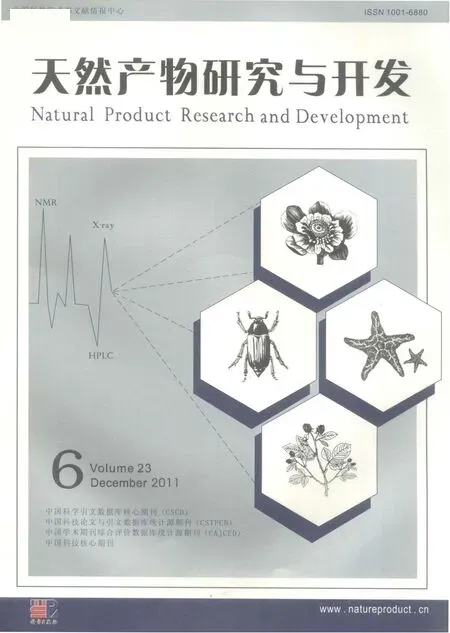小金梅草化学成分研究
程忠泉,杨 丹,马青云,刘玉清,周 俊,赵友兴,*
1中国科学院昆明植物研究所植物化学与西部资源持续利用国家重点实验室,昆明650204;2中国热带农业科学院热带生物技术研究所,海口571101;3桂林师范高等专科学校,桂林541001
Introduction
Plants of the family Hypoxidaceae are widely distributed in Torrid Zone in the world,and previous studies of the family by our group revealed that it mainly contains phenolic glycosides and norlignans[1-3].Hypoxis aurea Lour.belongs to the genus Hypoxidaceae,called as'xiao jin mei'to treat hernia and warm kidney in China[4]and mainly distributed over the southern part of China,southeast of Asia and Japan.Chemical investigation of the rhizomes of H.aurea toward potentially bioactive secondary metabolites from this genus leaded to the isolation of twelve compounds.These compounds were elucidated as quercetin-3-O-β-D-glucoside(1),kaemferol-3-O-β-D-glucoside(2),apigenin-5-O-β-D-glucopyranoside(3),α-spinasterol(4),2,6-dimethoxy-benzoic acid(5),1H-indole-3-carboxylic acid(6),(2S,3R,4E,8E)-1-(β-D-glucopyranosyloxy)-3-hydroxy-2[((R)-2-hydroxyeicosanoly)amino]-9-methy-4,8-octadecadiene(7),n-dotriacontanol(8),14,15-eicosenic acid(9),lignoceric acid(10),β-sitosterol (11)and daucosterol(12)on the basis of spectroscopic analysis and comparing spectral data with those known compounds reported in literatures.All these compounds were found in this plant for the first time.
Experimental
General
Melting points were measured on a XRC-1 micro-melting point apparatus and were uncorrected.MS spectra were obtained on a VG Auto Spec-3000 mass spectrometer.1H and13C(DEPT)NMR spectra were recorded on Bruker AM-400 MHz and DRX-500 MHz spectrometers,with chemical shifts(δ)in ppm relative to TMS as internal standard and coupling constants in hertz (Hz).Silica gel(200-300 mesh)for column chromatography was product of the Qingdao Marine Chemical Ltd.,Qingdao,P.R.China.Sephadex LH-20 for chromatography was purchased from Amersham Biosciences.Reversed-phase chromatography was with RP-18 (LiChroprep,40-63 μm,Merck,Darmstadt,Germany).
Plant materials
The whole plant of H.aurea.were collected in Kunming,Yunnan Province,People's Republic of China,in September 2008,and authenticated by professor Peng Hua.A voucher specimen(KUN 0864822)has been deposited in the Herbarium of Kunming Institute of Botany,Chinese Academy of Sciences.
Extraction and Isolation
The air-dried and powdered rhizomes of H.aurea(3.0 kg)were extracted three times each with 15 L of 95% EtOH under reflux for 3h.The extracts were evaporated and the residue was resuspended in 15 L of H2O and partitioned successively with petroleum ether(3 L× 3),EtOAc(3 L×3)and n-BuOH(3 L×3)to yield petroleum ether extract(49 g),EtOAc extract(70 g),n-BuOH extract(210 g),respectively.The n-BuOH (200 g)extract was applied to a silica gel column chromatography(200-300 mesh)eluted with CHCl3/ CH3OH/H2O(15∶3∶0.5,v/v)to give five fractions.Fraction 3(30 g)was purified by column chromatography silica gel with CHCl3/CH3OH/H2(7∶3∶0.5,v/ v),to yield four sub-fractions based on TLC analysis.Sub-fraction 2,were purified on RP-18 with 20% to 100%aqueous CH3OH,and on Sephadex LH-20 with CH3OH/CH3Cl(1∶1,v/v)to afford compounds 1(12 mg),2(8 mg)and 3(5 mg).EtOAc extract(60 g) was subjected to column chromatography on silica gel (200-300 mesh)column eluted with petroleum ether/ acetone(10∶1,v/v)to give five fractions.Sub-fraction 3(35 g)was repeatedly purified over silica gel(200-300 mesh)eluted with CHCl3/MeOH(from 20∶1 to 5∶1,v/v),and then on Sephadex LH-20 eluted with MeOH/CHCl3(1∶1,v/v)to yield compounds 4(14 mg),5(10 mg),6(5 mg),7(15mg),10(18 mg),11(146 mg)and 12(76 mg).Sub-fraction 1(19 g) was chromatographyed on silica gel(200-300 mesh) using petroleum ether/acetone(20∶1,v/v)as an eluant to give the compounds 8(258 mg)and 9(35 mg).
Results and Discussion
Quercetin-3-O-β-D-glucoside(1) Yellow powder,C21H20O12,mp.242-245℃,FABMS(-)m/z:463[M-H]-,1H NMR(CD3OD,400 MHz)δ:12.62(1H,s,OH),7.66(1H,t,J=8.4,2.1 Hz,H-6'),7.50 (1H,d,J=2.1 Hz,H-2'),6.80(1H,d,J=8.4 Hz,H-5'),6.39(1H,d,J=2.0 Hz,H-6),6.18(1H,d,J=2.0 Hz,H-8),5.36(1H,d,J=7.7 Hz,H-1''),3.15~3.63(11H,m,H-2''~ 6'').13C NMR (CD3OD,100 MHz)δ:156.3(C-2),133.4(C-3),177.5(C-4),161.3(C-5),98.7(C-6),164.2(C-7),93.6(C-8),156.3(C-9),103.9(C-10),121.1 (C-1'),122.4(C-2'),156.2(C-3'),148.4(C-4'),115.9(C-5'),122.0(C-6'),101.3(C-1''),71.2(C-2''),75.9(C-3''),67.9(C-4''),73.2(C-5''),60.2(C-6'').The MS and NMR data were identical to those of literature[5].
Kaemferol-3-O-β-D-glucoside(2)Yellow powder,C21H20O11,mp.178-179℃,FABMS(-)m/z:447[MH]-,1H NMR(CD3OD,500 MHz)δ:8.07(2H,d,J =8.9 Hz,H-2',6'),6.9(2H,d,J=8.9 Hz,H-3',5'),6.32(1H,d,J=1.8 Hz,H-8),6.14(1H,d,J= 1.8 Hz,H-6),5.08(1H,d,J=7.7 Hz,H-1''),3.81~3.30(11H,m,H-2''~6'').13C NMR(CD3OD,125 MHz)δ:158.7(C-2),132.3(C-3),179.3(C-4),161.6(C-5),95.3(C-6),168.6(C-7),93.3 (C-8),158.3(C-9),105.4(C-10),122.8(C-1'),135.5(C-2'),116.1(C-3'),158.7(C-4'),116.1 (C-5'),132.3(C-6'),105.2(C-1''),73.1(C-2''),77.1(C-3''),70.0(C-4''),75.1(C-5''),62.0(C-6'').The MS and NMR data were identical to those of literature[5].
Apigenin-5-O-β-D-glucopyranoside(3) Yellow powder,C21H20O10,mp.240-242℃,FABMS(-),m/ z:431[M-H]-.1H NMR(CD3OD,400 MHz)δ:8.10 (2H,d,J=8.8 Hz,H-2',6'),7.9(1H,s,H-3),6.9 (2H,d,J=8.8 Hz,H-3',5'),6.41(1H,d,J=1.9 Hz,H-8),6.21(1H,d,J=1.9 Hz,H-6),5.15(1H,d,J=7.8 Hz,H-1''),3.31~3.82(m)protons of glucose;13C NMR(CD3OD,100 MHz)δ:162.5(C-2),105.8(C-3),179.7(C-4),158.5(C-5),104.9 (C-6),161.6(C-7),99.9(C-8),158.3(C-9),108.5(C-10),122.7(1'),128.1(C-2'),116.1 (C-3'),160.9(C-4'),116.1(C-5'),128.5(C-6'),104.9(C-1''),73.0(C-2''),77.1(C-3''),67.0(C-4''),75.0(C-5''),61.9(C-6'').The MS and NMR data were identical to those of literature[6].
α-Spinasterol(4) Colorless powder,C29H52O3,mp.250-252℃,EIMS m/z:448[M]+,430,412,397;1H NMR(CDCl3,400 MHz)δ:0.82(3 H,s,19-CH3),0.83(3 H,d,J=8.6 Hz),0.84(3 H,d,J= 6.3 Hz),0.86(3 H,d,J=7.5 Hz),0.92(3H,d,J =6.6 Hz),1.19(3H,s,18-CH3),4.07(1H,m,H-3),3.52(1H,br s,H-6);13C NMR(CDCl3,100 MHz)δ:31.2(C-1),32.7(C-2),67.8(C-3),41.1 (C-4),76.3(C-5),76.4(C-6),34.3(C-7),28.4 (C-8),46.2(C-9),38.7(C-10),21.4(C-11),40.3(C-12),43.1(C-13),56.6(C-14),24.4(C-15),26.8(C-16),56.3(C-17),12.1(C-18),17.0 (C-19),36.4(C-20),19.3(C-21),34.9(C-22),26.8(C-23),46.3(C-24),29.7(C-25),18.9(C-26),19.9(C-27),23.5(C-28),12.3(C-29).The 1H and13C NMR data were identical to those of literature[7].
2,6-Dimethoxy-benzoic acid(5) Colourless powder,C9H10O4,mp.164-165℃,FABMS(+)m/z:183[M+1]+,165(M+-OH),150(165-CH3),137(M +-COOH),151(M+-OCH3);1H NMR(CD3OD,500 MHz)δ:3.80(6H,s,2OCH3),6.64(2H,d,J= 8.4 Hz,H-3,H-5),7.22(1H,d,J=8.4 Hz,H-4);13C NMR(CD3OD,125 MHz)δ:157.7(C-2,C-6),130.2(C-4),115.3(C-1),105.2(C-3,C-5),56.3 (2,6-OMe).The MS and NMR spectral data were in consistent with those reported[8].
1H-indole-3-carboxylic acid(6) Yellow powder,C9H7O2N,mp.210-215℃,EIMS m/z:161[M]+(100),144(98),116(26),89(16).1H NMR (CD3OD,400 MHz)δ:13.0(1H,br s,N-H),8.88 (1H,d,J=7.8 Hz,H-7),8.53(1H,d,J=2.7 Hz,H-2),7.61(1H,d,J=8.0 Hz,H-4),7.40(1H,t,J =7.8 Hz,H-6),7.32(1H,t,J=7.8 Hz,H-5).13C NMR(CD3OD,100 MHz)δ:133.0(C-2),108.7 (C-3),122.0(C-4),123.6(C-5),122.4(C-6),112.9(C-7),138.2(C-8),127.5(C-9),169.3 (COOH).The MS and NMR data were identical to those of literature[9].
(2S,3R,4E,8E)-1-(β-D-Glucopyranosyloxy)-3-hydroxy-2[(R)-2-hydroxyeicosanoly)amino]-9-methy-4,8-octadecadiene(7) Colorless powder,C45H85NO9,mp.190-192℃FABMS(m/z)(%)784[M+H]+(15),516(6),280(11).1H NMR (C5D5N,500 MHz)δ:8.36(1H,d,J=9.4 Hz,NH),4.95-4.19(protons of glucose),0.85(3H,t,J =6.9 Hz,H-18 or 21').13C NMR(C5D5N,125 MHz)δ:71.5(C-1),54.6(C-2),72.3(C-3),132.1(C-4),132.2(C-5),130.2(C-8),131.1(C-9),32.9(C-10),29.6-30.1(CH2),14.3(C-18),175.7(C-1'),72.5(C-2'),14.3(C-5'),105.7(C-1''),75.2(C-2''),78.5(C-3''),71.5(C-4''),78.6(C-5''),62.6(C-6'').The NMR data were identical to those of literature[10].
1-Dotriacontanol(8) White powder,C32H66O,mp.88-89℃,EIMS m/z:448[M-H2O]+,420(6),392(10),139(13).1H NMR(CDCl3,500 MHZ)δ: 0.88(3H,t,J=6.5 Hz),1.26~1.30(58H,br m),1.60(2H,m),3.64(2H,t,J=7.0 Hz,CH2OH);13C NMR(CDCl3,125 MHZ)δ:64.4(C-1),34.4 (C-2),31.9~22.7(C-3~31),14.1(C-32).The MS and NMR data were identical to those of literature[11].
14,15-Eicosenic acid(9) White solid,C20H36O2,mp.158-159℃,EIMS m/z:308[M]+,290[MH2O]+,266(6),239(10).1H NMR(CDCl3,400 MHZ)δ:0.88(3H,t,J=6.5 Hz),1.26~4.30 (30H,br m),5.24(2H,m).The MS and1H NMR data were identical to those of literature[12].
Lignoceric acid(10) White solid,C24H48O2,mp.72-73℃,EIMS m/z:368[M]+.1H NMR (CDCl3,400 MHZ)δ:0.87(3H,t,J=6.7 Hz),1.27-1.31(40H,br m),1.60(2H,m),2.44(2H,t,J= 7.0,CH2OH).The MS and NMR data were identical to those of literature[13].Compounds 11 and 12 were determined to be β-sitosterol and daucostero respectively by comparing their TLC behaviors with standard samples.
Acknowledgements This research was supported by the fund(P2008-ZZ22)of State Key Laboratory of Phytochemistry and Plant Resources in West China.We appreciate the analytical group of the State Key Laboratory of Phytochemistry and Plant Resources in West China,Kunming Institute of Botany,Chinese Academy of Sciences for all spectra tests.
1 Li N,Chen JJ,Zhou J.Four new phenolic compounds form Curculigo crassifolia.Helv Chim Acta,2004,87:845.
2 Li N,Tan NH,Zhou J.Three new norlignans from Curculigo capitulate.J Asian Nat Prod Res,2004,6:1-7.
3 Li N,Zhao YX,Jia AQ,et al.Study on the chemical constituents of Curculigo orchioides.Nat Prod Res Dev(天然产物研究与开发),2003,15:208-211.
4 Zhao SX,Huang TK,Ding ZJ,et al.Zhongyao Cihai,3.Bejing:Chinese Medical Science and Technology Press,1997.294.
5 Zhang PF,Li C.Flavones from flowers of Paulownia fortunei.China J Chin Mater Med,2008,22:2629-2632.
6 Qiu J,Qin MJ,Tang N.On chemical constituents in aboveground part of Scutellaria barbata.J Plant Resour Env,2009,1:91-93.
7 Kang J.Studies on the chemical constituents and extracting technology in Albizzia julibrissin flower.Shijiazhuang:Hebei Medical University,PhD.2006.
8 Cheng CX,Ni W,Mei WL.Glycosides from Curculigo orchiodes.Chem Res Appl,1999,5:511-512.
9 Feng Y,Li XM,Wang BG.Chemical constituents in aerial parts of mangrove plant Avicennia marina.Chin Tradit Her Drug,2007,38:1301-1303.
10 He XX,Yan SJ,Zeng LM,et al.Studies on the secondary metabolites of the soft coral Lobophytum sp.(II).J SUN YATSEN University,Nat Sci,2005,5:113-115.
11 Zhang SL,Liu JC,Yang GZ.Studies on the pesticide biological activity substances from plants-Studies on the chemical constituents of Sapium sebiferum(II).J Centr China Norm Univ,Nat Sci,1995,4:477-480.
12 Yang XF,Lei HM,Fu HZ,et al.Chemical constituents from the seeds of Koelaeuteria paniculata laxm.Acta Pharm Sin,2000,4:279-283.
13 Zhang JH,Zhao YY,Liu QX,et al.Studies on the chemical constituents from Sophora flavescens Ait.China J Chin Mater Med,2000,1:37-38.

